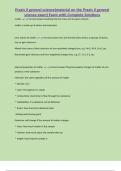Praxis II general science(material on the Praxis II general
science exam) Exam with Complete Solutions
matter Correct answer-anything that has mass and occupies volume
matter is made up of atoms and molecules
ionic nature of matter Correct answer-Ions are formed when atoms, or groups of atoms,
lose or gain electrons.
Metals lose some of their electrons to form positively charged ions, e.g. Fe+2, Al+3, Cu+2, etc.
Nonmetals gain electrons and form negatively charged ions, e.g. Cl-, O-2, S-2, etc.
physical properties of matter Correct answer-Physical property changes of matter do not
produce a new substance
Intensive: the same regardless of the amount of matter
* density: m/v
* color: The pigment or shade
* conductivity: electricity to flow through the substance
* malleability: if a substance can be flattened
* luster: how shiny the substance looks
melting and freezing point
Extensive: will change if the amount of matter changes.
* mass: how much matter in the sample
* volume: How much space the sample takes up
* length: How long the sample is
,Praxis II general science(material on the Praxis II general
science exam) Exam with Complete Solutions
chemical properties of matter Correct answer-any of a material's properties that
becomes evident during a chemical reaction-any quality that can be established only by
changing a substance's chemical identity
* Reactivity against other chemical substances
* Heat of combustion
* Enthalpy of formation
* Toxicity
* Chemical stability in a given environment
* Flammability
* Preferred oxidation state(s)
* Coordination number
* Capability to undergo a certain set of transformations, for ex chemical combination, redox
reactions
* Preferred types of chemical bonds to form, for example metallic, ionic, covalent
organization of matter Correct answer-pure substance: no separation by physical means
chemical element: pure chemical substance consisting of one type of atom distinguished by its
atomic number, which is the number of protons in its nucleus
chemical compound: pure chemical substance consisting of two or more different chemical
elements that can be separated into simpler substances by chemical reactions
Solutions: molecules that are mixed up in a completely even distribution, homogenous systems
mixture: substances held together by physical forces, not chemical, can be homogeneous and
heterogeneous
,Praxis II general science(material on the Praxis II general
science exam) Exam with Complete Solutions
A homogeneous mixture is called a solution
Elements Correct answer-pure chemical substance, one type of atom, distinguished by its
atomic number (Z), the number of protons in its nucleus
# of protons determines chemical properties
Mass number (A) is the number of nucleons (p+N) in nucleus
Oxygen most abundant on earth, Hydrogen most abundant in universe
Elements with atomic numbers 83 or higher are inherently unstable, and undergo radioactive
decay
The abundance of the lightest elements is well predicted by the standard cosmological model,
since they were produced shortly after the Big Bang, in a process known as Big Bang
nucleosynthesis. Heavier elements were mostly produced much later, inside stars.
chemical change Correct answer-* Decomposition
* Neutralization (Mixing acid+base=water and a salt).
* Photosynthesis -co2 and water are changed into sugars.
* Cooking examples: cake, pancakes, and eggs/bacon
* Oxidation examples: rust or tarnishing
* Ripening examples: bananas, tomatoes or potatoes
Evidence
* Change of odor
* Change of color
, Praxis II general science(material on the Praxis II general
science exam) Exam with Complete Solutions
* Change in temp or energy, such as the production (exothermic) or loss (endothermic) of heat.
* Change of form (for example, burning paper).
* Light, heat, or sound is given off.
* Formation of gases, often appearing as bubbles.
* Formation of precipitate (insoluble particles).
* The decomposition of organic matter (for ex rotting food).
How did Dalton's atomic theory help support the law of conservation of mass? Correct
answer-According to Dalton's atomic theory :
1. All matter is made up of atoms
2. ATOMS CAN NEITHER BE CREATED NOR DESTROYED
3. Atoms of the same element are identical
4. Atoms of different elements have different properties
5. compounds consisted of atoms of different elements combined together in a particular ratio
forms of energy Correct answer-heat, light, sound, electrical, chemical, nuclear and
mechanical
Work is the amount of energy transferred during an interaction
amount of energy before a transformation = amount of energy after. In most energy
transformations, some energy is converted to thermal energy.
fusion vs fission Correct answer-fission splits a massive element into fragments, releasing




